Analysis of a Legal Regulation Approach and Strategy of a Sharing Economy Based on Technological Change and Sustainable Development
Abstract
:1. Introduction
2. Related Works
2.1. Economic Development
2.2. Sustainability
2.3. Artificial Intelligence
3. Proposed Conservative Regulation Approach
3.1. CNN-Based Stability Validation
3.2. Sustainability Analysis
4. Comparative Study
4.1. Recommendation Ratio
4.2. Data Analysis Rate
4.3. Sustainability Feature
4.4. Sharing Ratio
4.5. Analysis Time
4.6. Results Summary
5. Conclusions
Author Contributions
Funding
Institutional Review Board Statement
Informed Consent Statement
Data Availability Statement
Conflicts of Interest
References
- Abdulov, R. Artificial Intelligence as an Important Factor of Sustainable and Crisis-Free Economic Growth. Procedia Comput. Sci. 2020, 169, 468–472. [Google Scholar] [CrossRef]
- Cui, L.; Yang, K.; Lei, Z.; Lim, M.K.; Hou, Y. Exploring stakeholder collaboration based on the sustainability factors affecting the sharing economy. Sustain. Prod. Consum. 2022, 30, 218–232. [Google Scholar] [CrossRef]
- Gu, W.; Wang, J. Research on index construction of sustainable entrepreneurship and its impact on economic growth. J. Bus. Res. 2022, 142, 266–276. [Google Scholar] [CrossRef]
- Brenner, B.; Hartl, B. The perceived relationship between digitalization and ecological, economic, and social sustainability. J. Clean. Prod. 2021, 315, 128128. [Google Scholar] [CrossRef]
- Norouzi, N. Learning Economy: A New Hope to Achieve a Sustainable Economic System. Circ. Econ. Sustain. 2021, 2, 535–555. [Google Scholar] [CrossRef]
- Grinevich, V.; Huber, F.; Karataş-Özkan, M.; Yavuz, Ç. Green entrepreneurship in the sharing economy: Utilising multiplicity of institutional logics. Small Bus. Econ. 2019, 52, 859–876. [Google Scholar] [CrossRef] [Green Version]
- Light, A.; Miskelly, C. Platforms, scales, and networks: Meshing a local, sustainable sharing economy. Comput. Support. Coop. Work 2019, 28, 591–626. [Google Scholar] [CrossRef] [Green Version]
- Pankov, S.; Velamuri, V.K.; Schneckenberg, D. Towards sustainable entrepreneurial ecosystems: Examining the effect of contextual factors on sustainable entrepreneurial activities in the sharing economy. Small Bus. Econ. 2021, 56, 1073–1095. [Google Scholar] [CrossRef]
- Kozlenkova, I.V.; Lee, J.-Y.; Xiang, D.; Palmatier, R.W. Sharing economy: International marketing strategies. J. Int. Bus. Stud. 2021, 52, 1445–1473. [Google Scholar] [CrossRef]
- Panniello, U.; Ardito, L.; Petruzzelli, A.M. Scoping the state of the sharing economy and its antecedents at the country level: Cross-country differences in Europe. Geoforum 2022, 133, 140–152. [Google Scholar] [CrossRef]
- Sanchez-Cartas, J.M.; Katsamakas, E. Artificial Intelligence, algorithmic competition, and market structures. IEEE Access 2022, 10, 10575–10584. [Google Scholar] [CrossRef]
- Ren, J. Research on Financial Investment Decision Based on Artificial Intelligence Algorithm. IEEE Sens. J. 2021, 21, 25190–25197. [Google Scholar] [CrossRef]
- Najem, R.; Amr, M.F.; Bahnasse, A.; Talea, M. Artificial Intelligence for Digital Finance, Axes and Techniques. Procedia Comput. Sci. 2022, 203, 633–638. [Google Scholar] [CrossRef]
- Gmeiner, R.; Harper, M. Artificial intelligence and economic planning. AI Soc. 2022. [Google Scholar] [CrossRef]
- Ahmadi, M.; Jafarzadeh-Ghoushchi, S.; Taghizadeh, R.; Sharifi, A. Presentation of a new hybrid approach for forecasting economic growth using artificial intelligence approaches. Neural Comput. Appl. 2019, 31, 8661–8680. [Google Scholar] [CrossRef]
- Chen, Z.; Zhang, L.; Tian, G.; Nasr, E.A. Economic Maintenance Planning of Complex Systems Based on Discrete Artificial Bee Colony Algorithm. IEEE Access 2020, 8, 108062–108071. [Google Scholar] [CrossRef]
- Norbu, S.; Couraud, B.; Robu, V.; Andoni, M.; Flynn, D. Modeling Economic Sharing of Joint Assets in Community Energy Projects Under LV Network Constraints. IEEE Access 2021, 9, 112019–112042. [Google Scholar] [CrossRef]
- Cook, D.; Davíðsdóttir, B. An appraisal of interlinkages between macro-economic indicators of economic well-being and the sustainable development goals. Ecol. Econ. 2021, 184, 106996. [Google Scholar] [CrossRef]
- Gu, W.; Wang, J.; Hua, X.; Liu, Z. Entrepreneurship and high-quality economic development: Based on the triple bottom line of sustainable development. Int. Entrep. Manag. J. 2020, 17, 1–27. [Google Scholar] [CrossRef]
- Eisenmenger, N.; Pichler, M.; Krenmayr, N.; Noll, D.; Plank, B.; Schalmann, E.; Wandl, M.-T.; Gingrich, S. The Sustainable Development Goals prioritize economic growth over sustainable resource use: A critical reflection on the SDGs from a socio-ecological perspective. Sustain. Sci. 2020, 15, 1101–1110. [Google Scholar] [CrossRef]
- Dabbous, A.; Tarhini, A. Assessing the impact of knowledge and perceived economic benefits on sustainable consumption through the sharing economy: A sociotechnical approach. Technol. Forecast. Soc. Change 2019, 149, 119775. [Google Scholar] [CrossRef]
- Taheri, F.; Moghaddam, B.F. A heuristic-based hybrid algorithm to configure a sustainable supply chain network for medical devices considering information-sharing systems. Environ. Sci. Pollut. Res. 2022, 29, 91105–91126. [Google Scholar] [CrossRef] [PubMed]
- Zaery, M.; Wang, P.; Wang, W.; Xu, D. Distributed Global Economical Load Sharing for a Cluster of DC Microgrids. IEEE Trans. Power Syst. 2020, 35, 3410–3420. [Google Scholar] [CrossRef]
- Wang, Y.; Xiang, D.; Yang, Z.; Ma, S. Unraveling customer sustainable consumption behaviors in sharing economy: A socio-economic approach based on social exchange theory. J. Clean. Prod. 2019, 208, 869–879. [Google Scholar] [CrossRef]
- Oakley, J.L.; Wilson, K.J.; Philipson, P. A condition-based maintenance policy for continuously monitored multi-component systems with economic and stochastic dependence. Reliab. Eng. Syst. Saf. 2022, 222, 108321. [Google Scholar] [CrossRef]
- Rashid, Z.; Noor, U.; Altmann, J. Economic model for evaluating the value creation through information sharing within the cybersecurity information sharing ecosystem. Futur. Gener. Comput. Syst. 2021, 124, 436–466. [Google Scholar] [CrossRef]
- Güler, K.; Tepecik, A. Exchange Rates’ Change by Using Economic Data with Artificial Intelligence and Forecasting the Crisis. Procedia Comput. Sci. 2019, 158, 316–326. [Google Scholar] [CrossRef]
- Hoosain, M.S.; Paul, B.; Ramakrishna, S. The Impact of 4IR Digital Technologies and Circular Thinking on the United Nations Sustainable Development Goals. Sustainability 2020, 12, 10143. [Google Scholar] [CrossRef]
- Chen, M.; Liu, Q.; Huang, S.; Dang, C. Environmental cost control system of manufacturing enterprises using artificial intelligence based on value chain of circular economy. Enterp. Inf. Syst. 2020, 16, 1856422. [Google Scholar] [CrossRef]
- Endharta, A.J.; Ko, Y.M. Economic Design and Maintenance of a Circular k-Out-of-n: G Balanced System With Load-Sharing Units. IEEE Trans. Reliab. 2020, 69, 1465–1479. [Google Scholar] [CrossRef]
- Standing, C.; Standing, S.; Biermann, S. The implications of the sharing economy for transport. Transp. Rev. 2018, 39, 226–242. [Google Scholar] [CrossRef]
- Xiao, G.; Xiao, Y.; Ni, A.; Zhang, C.; Zong, F. Exploring influence mechanism of bikesharing on the use of public transportation—A case of Shanghai. Transp. Lett. 2022, 1–9. [Google Scholar] [CrossRef]
- Korinek, A.; Stiglitz, J.E. Artificial Intelligence, Globalization, and Strategies for Economic Development (No. w28453); National Bureau of Economic Research: Cambridge, MA, USA, 2021. [Google Scholar]
- Pouri, M.J.; Hilty, L.M. The digital sharing economy: A confluence of technical and social sharing. Environ. Innov. Soc. Transitions 2021, 38, 127–139. [Google Scholar] [CrossRef]
- Roberts, D. US Economic Profile by County 1969–2019. Available online: https://www.kaggle.com/datasets/davidbroberts/us-economic-profile-by-county (accessed on 8 August 2021).
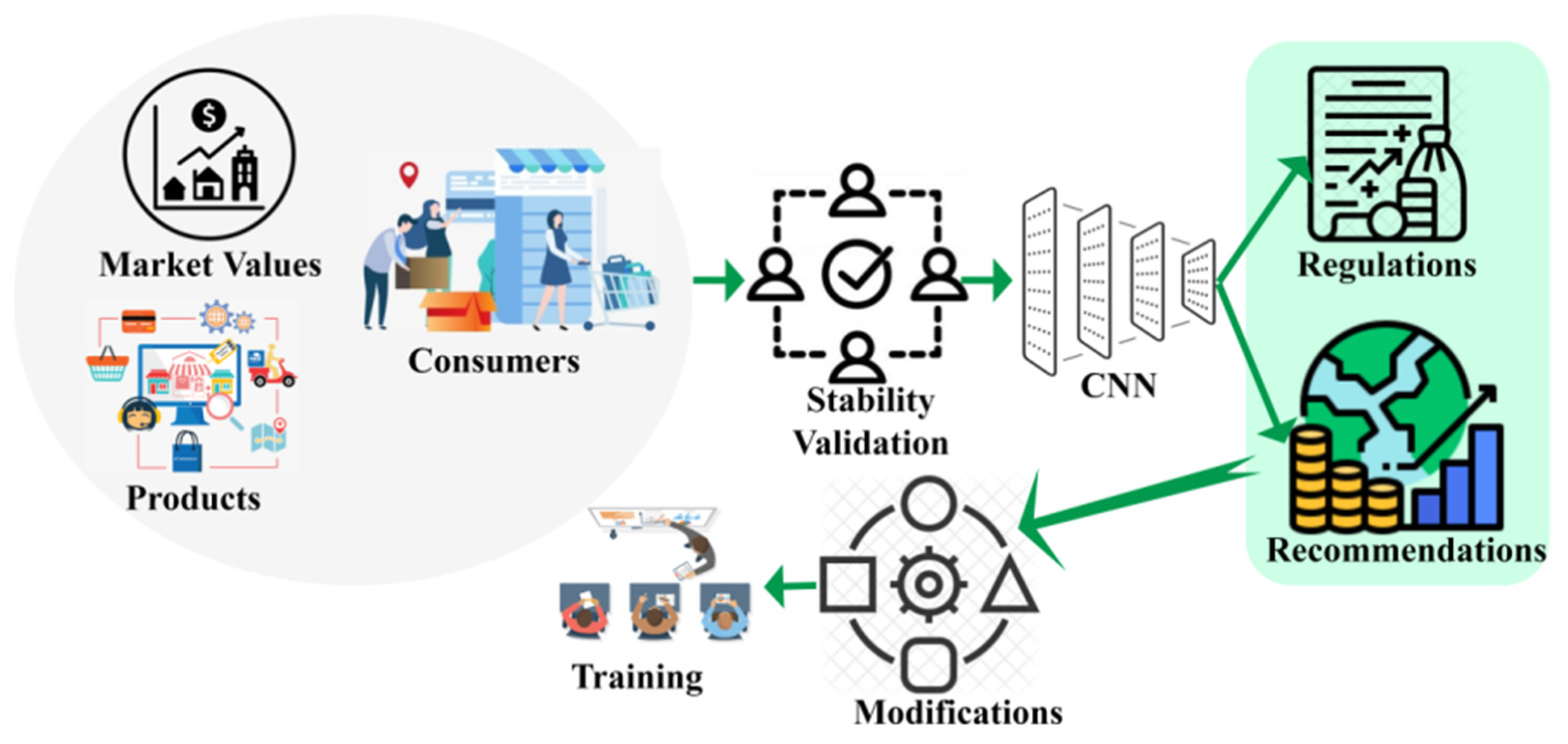


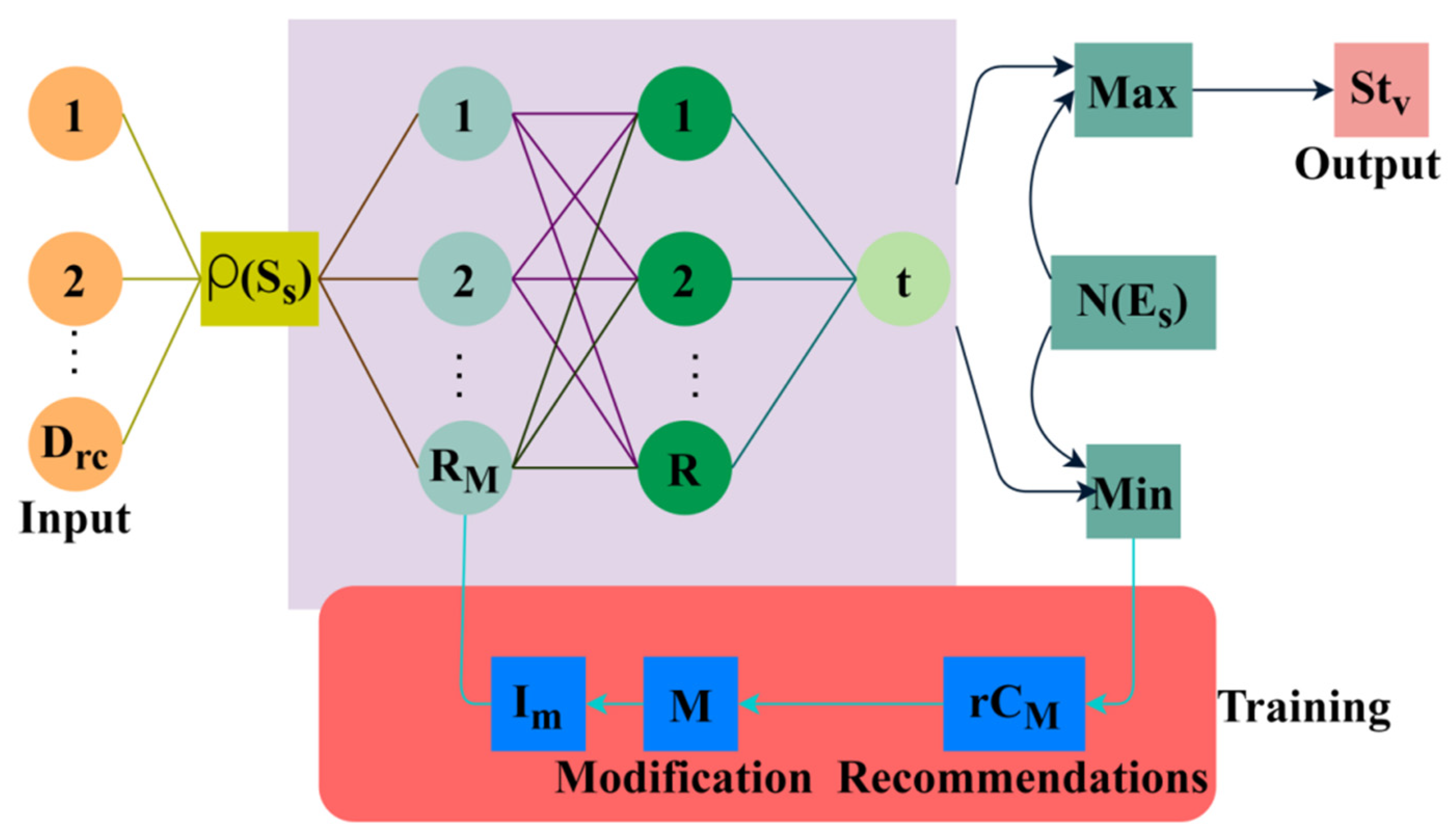
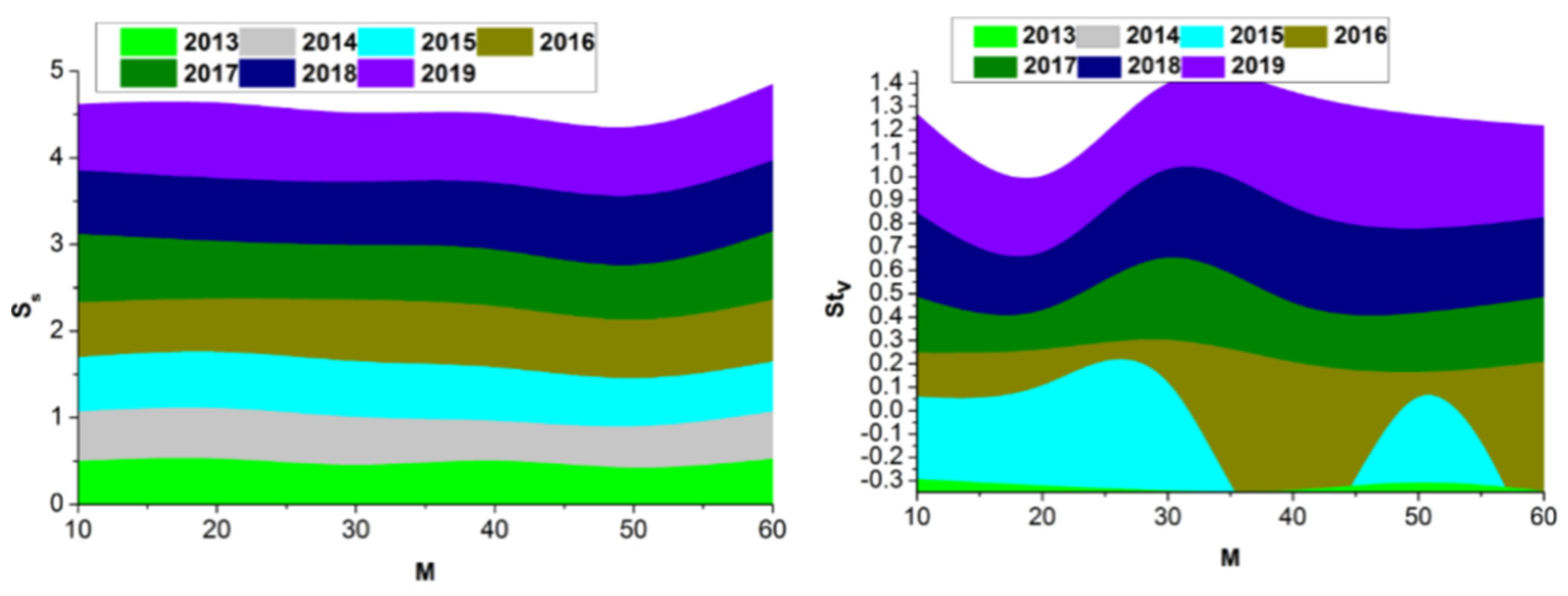

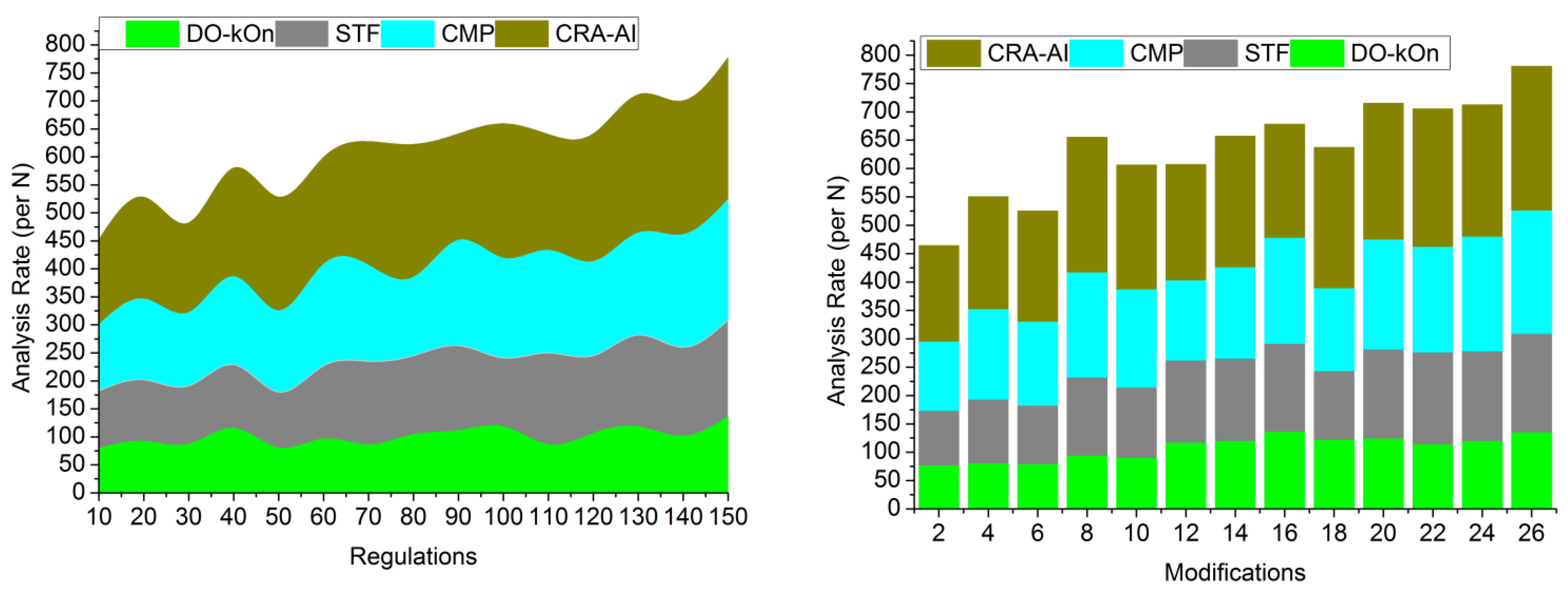


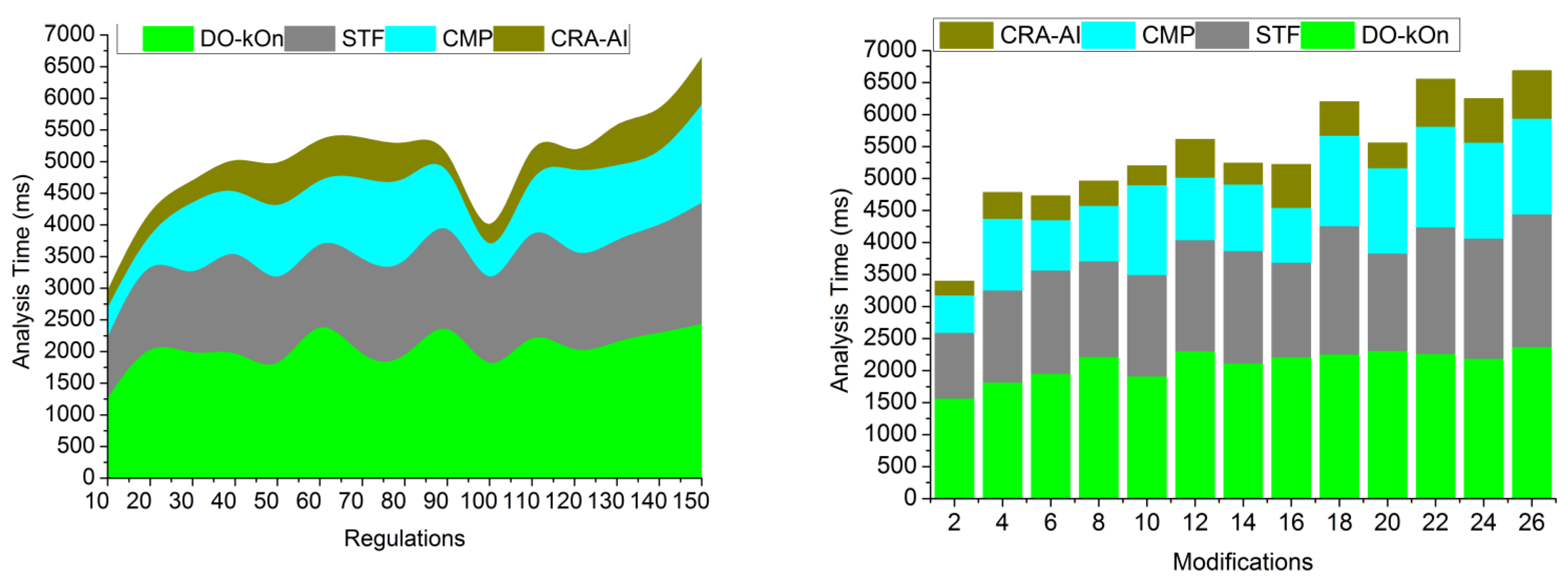
| Year | Quarter | Cumulative Economic Products | |||
|---|---|---|---|---|---|
| 2013 | Q1 | 87 | 0.34 | 57.61 | 70.08 |
| Q2 | 93 | 0.42 | 54.42 | 71.25 | |
| Q3 | 86 | 0.51 | 56.98 | 73.69 | |
| Q4 | 91 | 0.48 | 54.58 | 72.58 | |
| 2014 | Q1 | 114 | 0.56 | 55.74 | 78.58 |
| Q2 | 102 | 0.59 | 52.47 | 81.25 | |
| Q3 | 119 | 0.61 | 53.69 | 75.14 | |
| Q4 | 120 | 0.39 | 56.36 | 83.69 | |
| 2015 | Q1 | 168 | 0.68 | 55.23 | 85.47 |
| Q2 | 178 | 0.72 | 51.36 | 82.36 | |
| Q3 | 247 | 0.64 | 48.96 | 80.14 | |
| Q4 | 269 | 0.71 | 41.26 | 82.36 | |
| 2016 | Q1 | 247 | 0.69 | 31.58 | 89.56 |
| Q2 | 364 | 0.75 | 28.97 | 84.25 | |
| Q3 | 389 | 0.81 | 25.47 | 85.69 | |
| Q4 | 415 | 0.79 | 21.69 | 88.61 | |
| 2017 | Q1 | 468 | 0.81 | 51.48 | 90.25 |
| Q2 | 489 | 0.92 | 36.25 | 91.54 | |
| Q3 | 475 | 0.89 | 32.54 | 89.47 | |
| Q4 | 486 | 0.92 | 28.96 | 92.14 | |
| 2018 | Q1 | 498 | 0.78 | 25.69 | 91.25 |
| Q2 | 458 | 0.72 | 27.48 | 93.65 | |
| Q3 | 369 | 0.58 | 28.69 | 94.18 | |
| Q4 | 421 | 0.91 | 25.89 | 92.36 | |
| 2019 | Q1 | 503 | 1 | 18.51 | 93.65 |
| Q2 | 499 | 1 | 18.51 | 94.12 | |
| Q3 | 469 | 0.89 | 21.45 | 93.25 | |
| Q4 | 471 | 0.72 | 22.51 | 94.41 |
| Years | Quarter | Cumulative Products | |||
|---|---|---|---|---|---|
| 2013 | Q1 | 86 | −0.0652 | 0.59 | 21 |
| Q4 | 92 | ||||
| 2014 | Q1 | 112 | −0.0967 | 0.68 | 15 |
| Q4 | 124 | ||||
| 2015 | Q1 | 132 | −0.102 | 0.49 | 12 |
| Q4 | 147 | ||||
| 2016 | Q1 | 269 | −0.313 | 0.52 | 25 |
| Q4 | 392 | ||||
| 2017 | Q1 | 341 | −0.114 | 0.61 | 27 |
| Q4 | 385 | ||||
| 2018 | Q1 | 412 | −0.138 | 0.72 | 31 |
| Q4 | 478 | ||||
| 2019 | Q1 | 503 | 0.0278 | 0.88 | 39 |
| Q4 | 489 |
| Metrics | DO-kOn | STF | CMP | CRA-AI |
|---|---|---|---|---|
| Recommendation Ratio | 78.15 | 85.13 | 89.59 | 94.336 |
| Analysis Rate (per N) | 136 | 173 | 215 | 253 |
| Sustainability Factor | 0.575 | 0.676 | 0.767 | 0.8832 |
| Sharing Ratio | 79.75 | 85.96 | 90.39 | 97.272 |
| Analysis Time (ms) | 2428.99 | 1915.81 | 1544.62 | 748.347 |
| Metrics | DO-kOn | STF | CMP | CRA-AI |
|---|---|---|---|---|
| Recommendation Ratio | 78.17 | 85.77 | 89.94 | 94.279 |
| Analysis Rate (per N) | 136 | 174 | 217 | 253 |
| Sustainability Factor | 0.565 | 0.666 | 0.751 | 0.8816 |
| Sharing Ratio | 79.42 | 85.29 | 90.69 | 96.383 |
| Analysis Time (ms) | 2375.99 | 2071.4 | 1495.81 | 741.113 |
Disclaimer/Publisher’s Note: The statements, opinions and data contained in all publications are solely those of the individual author(s) and contributor(s) and not of MDPI and/or the editor(s). MDPI and/or the editor(s) disclaim responsibility for any injury to people or property resulting from any ideas, methods, instructions or products referred to in the content. |
© 2023 by the authors. Licensee MDPI, Basel, Switzerland. This article is an open access article distributed under the terms and conditions of the Creative Commons Attribution (CC BY) license (https://creativecommons.org/licenses/by/4.0/).
Share and Cite
Wu, Z.; Zhou, W.; Yu, A. Analysis of a Legal Regulation Approach and Strategy of a Sharing Economy Based on Technological Change and Sustainable Development. Sustainability 2023, 15, 1056. https://doi.org/10.3390/su15021056
Wu Z, Zhou W, Yu A. Analysis of a Legal Regulation Approach and Strategy of a Sharing Economy Based on Technological Change and Sustainable Development. Sustainability. 2023; 15(2):1056. https://doi.org/10.3390/su15021056
Chicago/Turabian StyleWu, Zixi, Wen Zhou, and Aisi Yu. 2023. "Analysis of a Legal Regulation Approach and Strategy of a Sharing Economy Based on Technological Change and Sustainable Development" Sustainability 15, no. 2: 1056. https://doi.org/10.3390/su15021056





